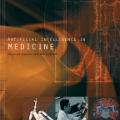The spatial resolution of images of living samples obtained by fluorescence microscopes is physically limited due to the diffraction of visible light, which makes the study of entities of size less than the diffraction barrier (around 200 nm in the x-y plane) very challenging. To overcome this limitation, several deconvolution and super-resolution techniques have been proposed. Within the framework of inverse problems, modern approaches in fluorescence microscopy reconstruct a super-resolved image from a temporal stack of frames by carefully designing suitable hand-crafted sparsity-promoting regularisers. Numerically, such approaches are solved by proximal gradient-based iterative schemes. Aiming at obtaining a reconstruction more adapted to sample geometries (e.g. thin filaments), we adopt a plug-and-play denoising approach with convergence guarantees and replace the proximity operator associated with the explicit image regulariser with an image denoiser (i.e. a pre-trained network) which, upon appropriate training, mimics the action of an implicit prior. To account for the independence of the fluctuations between molecules, the model relies on second-order statistics. The denoiser is then trained on covariance images coming from data representing sequences of fluctuating fluorescent molecules with filament structure. The method is evaluated on both simulated and real fluorescence microscopy images, showing its ability to correctly reconstruct filament structures with high values of peak signal-to-noise ratio (PSNR).
翻译:通过可见光的衍射,荧光显微镜拍摄的活体样本图像受到物理上的空间分辨率限制,这使得研究小于衍射界限(约为 x-y 平面上的 200nm)大小的细胞结构非常具有挑战性。为了克服这种限制,已经提出了一些反卷积和超分辨率技术。在反问题的框架下,现代的荧光显微镜方法通过精心设计相应的稀疏正则化器来重新构建超分辨率图像。在数值上,这些方法是通过近端梯度迭代方案进行求解。为了获得更适合样本几何形状(例如薄丝状结构)的重建,我们采用了一种插件式去噪方法,具有收敛保证,并使用图像去噪器(预训练的神经网络)替换与显式图像正则化器相关的接近算子,该去噪器通过适当的训练来模仿隐式先验的作用。为考虑分子之间涨落的独立性,该模型依赖于二阶统计量。然后,通过来自于表示具有丝状结构的涨落荧光分子序列的协方差图像的数据对去噪器进行训练。该方法在模拟和真实荧光显微镜图像上进行了评估,显示出其能够以高峰值信噪比(PSNR)正确重构丝状结构的能力。



